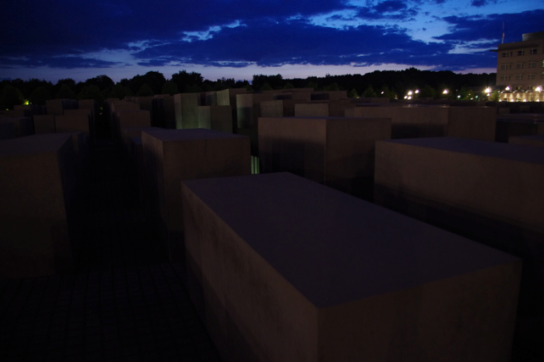By Nick Ubels (The Cascade) – Email
Print Edition: October 10, 2012
My friend and I arrived in Berlin in the late afternoon. A little exhausted from the day’s travel, we spent the evening exploring the city rather than making any definite plans.
After sunset, we found ourselves at Potsdamer Platz, a thriving and ultra-modern public square and commercial centre anchored by three cinemas, the colourfully lit-up canvas roof of the Sony Centre, and a series of impressively daunting glass and steel skyscrapers. The square was only restored after German reunification, having been laid to waste during the Second World War and cleaved in two by the Berlin Wall for the duration of the Cold War.
We followed the line of white bricks that represent the wall’s former path south down Ebertstraße until we came across something peculiar. An entire block filled with rows of concrete slabs of varying heights. From the sidewalk, it seemed as though many of the nearly 3000 columns only came up to a height of about four feet at most. Intrigued, we silently began walking down parallel paths into the middle of the site. Suddenly the ground started descending at a steep incline. The concrete blocks which had seemed tiny from afar now towered ominously, maybe 10 or 12 feet above my head. I caught only rare glimpses of my friend as we walked further and further towards the centre. At this altitude, I was totally cut off from the bustling sounds of the traffic and the city. It was dark, silent and terrifying. I was completely isolated in my journey, unsure where I was headed and overwhelmed by somber contemplation of the violent history I then realized was memorialized here.
The Memorial to the Murdered Jews of Europe is an incredibly moving and thought-provoking experience. It subtly acts on the visitor by recreating a small sense of the overwhelming hopelessness felt by European Jews persecuted during the Holocaust. It would be difficult to produce the same effect through photographs or other documents to which we can easily become desensitized, viewing them from the comfort of our homes or libraries. But the memorial in the heart of Berlin causes those who encounter it to empathize more strongly with the victims of the Nazi regime by subtly intimidating the visitor, by making them uncomfortable.
Below the public exhibit is a free information centre that adds personal detail by featuring the stories of several victims told through photographs, personal documents and other media.
The 2711 concrete blocks, designed by architect Peter Eisenman and opened to the public in 2005, are said to represent gravestones, the trains used to carry victims to concentration camps, or perhaps the barracks used to house those held prisoner there. It is a bleak, grey sight. There is a terrible sense of supposed order masking an utter lack of humanity. The regular rows and columns seem to simulate the systematic manner in which these murders were carried out. From afar, one does not get any sense of the scope or depth of the memorial, perhaps in an attempt to mimic the way in which unspeakable horrors can go unchecked when we do not stay actively vigilant in our defence of human rights. Upon entering the memorial, one is quickly isolated from any friends, family or fellow visitors they arrived with, simulating the way in which so many families and friends were separated from each other.
The memorial is located in a high-visibility area near what might be the nation’s biggest tourist attraction (The Brandenburg Gate), and the very name “Memorial to the Murdered Jews of Europe” contains an explicit acknowledgement of the systematic genocide of an ethnic-religious minority.
It struck me as a bracingly honest manner for contemporary Germans to attempt to reconcile with this brutal chapter in their recent history. The rhetoric of the Nationalist-Socialist Party sought to define German citizenship along racial lines and there is no attempt to wash over the details of this atrocity.
In light of UFV’s new Peace Studies program, it is worth remembering that peace means much more than just the absence of war.



